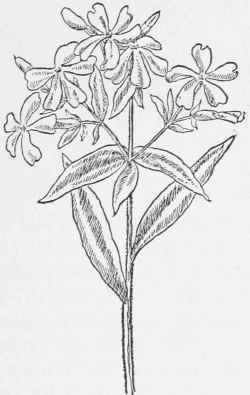Polemoniaceae - Phlox Family. Phlox Phlox Divaricata. Phlox, Flame, Is An Ancient Name Transferred To This Genus
Description
This section is from the book "Our Early Wild Flowers", by Harriet Louise Keeler. See also: Newcomb's Wildflower Guide.
Polemoniaceae - Phlox Family. Phlox Phlox Divaricata. Phlox, Flame, Is An Ancient Name Transferred To This Genus
Perennial. Moist open woods and fields. Ontario to Minnesota, south to Florida, Kansas, and Arkansas.
Abundant in northern Ohio. April, May.
Stem
Downy, erect or diffuse, with creeping prostrate or ascending leafy shoots.
Leaves
Of flowering stems opposite, ovate-lanceolate or oblong, mostly acute; the uppermost almost clasping.
Flowers
Pale lilac-purple, in loose, spreading clusters, faintly fragrant.
Calyx
Five-toothed; teeth slender and pointed.
Corolla
Salver-shaped, five-lobed with long tube; lobes obcordate or obovate and notched, convolute in bud.
Stamens
Five, unequal, inserted on the corolla-tube and alternate with its lobes, included.

Phlox. Phlox divaricata
Pistil
Ovary three-celled; style threadlike; stigmas three.
Fruit
Oblong-globose capsule.
This is one of the flowers so abundant both in April and May that one scarcely knows in which month to place it. In color it varies from pale lilac to nearly white. Like all the Phloxes, its corolla is salver-shaped, this word referring to the ancient salver whose handle was a tube extending below the tray, rather than to our modern form. It is very pretty in masses, but its color is not decided enough to be effective alone, and its loose clusters look a little ragged. The Phlox Drummondii of the gardens is a Texan species, which has been developed into numerous varieties.
Continue to:


